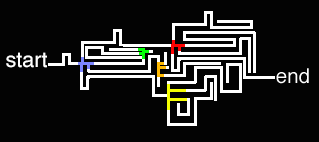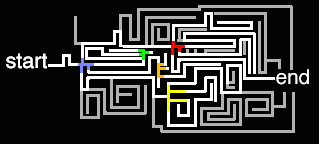glazedkoala
Ethan joined
The designer, developer, and artist for Super Happy Fun Block!
Recently I released a new beta build of Super Happy Fun Block to testers. There were a few mechanic changes, some art changes, and some new puzzles. The biggest change however was to existing puzzles. The order players encounter them in was completely changed and many were adjusted slightly to be easier. This was to address a problem that players have had since the first build of the game: it was just too hard. In a way, I take a lot of pride in this fact. I set out to make a puzzle game that really required people to think; that required players to be smart, not just make them feel smart. I wanted each puzzle to be unique and interesting. But when players are struggling through very early puzzles, or worse - struggling through every single puzzle, it’s a problem. It’s stressful and it’s unpleasant. To figure out how to make a puzzle easier while still remaining interesting I had to determine what actually made a puzzle difficult. The answer is a number of factors, but they can be grouped into three basic categories: complexity, exploration, and intuitiveness. This post will be covering complexity.
Complexity
Complexity is a no brainer. A more complex puzzle is harder. What’s a little more interesting is what makes a puzzle complex. Many games seem to think that the important thing here is making a puzzle longer. If a puzzle takes more steps to solve, it is harder than a puzzle that takes less. This is definitely a factor, especially when combined with other techniques to ramp up difficulty, but it’s actually a bad way to measure a puzzle’s complexity. A much better indicator is the number of plausible actions a player can take at any given step. A plausible action is something the player can do (press a button, push a block, cut a rope, shoot a bird) that appears to be a possible step towards solving a puzzle. If a player thinks ahead, they may be able to determine that the action is incorrect without even attempting it, but for now let’s assume they aren’t thinking ahead.
Step Count
Imagine a puzzle will take a player 20 actions to complete. This certainly sounds complicated. But if there’s only ever one plausible action available to them, then it’s actually quite simple. The player just does the one action available to them and moves on. We can picture this puzzle as the following maze:
At first glance this maze might look complex to somebody. It’s certainly tightly packed in parts. But if you just start the maze you’ll find that there are no dead ends. There are 20 turns, but never any branching paths. Despite appearances, the maze wouldn’t be any simpler if it were a straight line.
Plausible Action Count
What truly increases the complexity of a puzzle is the number of plausible actions at any given point. Imagine a puzzle that starts with four plausible actions. If a player randomly tries one, they find that there are now four new plausible actions they can take. Each of those leads to four more possible actions. Each of those actions either obviously lead to failure when attempted or, in one case, is the correct solution. This puzzle has 64 possible “paths” that could lead to the solution (4^3). Let’s look at a maze that has just four plausible actions followed by four plausible actions - 16 paths (4^2). Each split is colored to help you spot them.

This is much more complicated than the first maze. Trying every possible path at random to find a solution would take a long time, so now a player is more likely to try to think ahead. Perhaps they can easily eliminate a junction that dead ends quickly (like green). Maybe they’ll try to start the maze from the end instead of the beginning (in this case, that’d get you the solution quickly). The important thing to note here is that we’ve created a much more complicated maze which encourages a player to think before blindly diving into it.
Lost In A Straight Hallway
In a puzzle game like Super Happy Fun Block, this maze belies the actual complexity the player experiences. In a maze, you can clearly see where there are splits in the path and, importantly, you can see where there are no splits in the path. If a player ran into a puzzle with this many possible paths, they may not actually identify where the splits even exist. They may only notice 2 of the 4 possible paths they can take. If the paths they easily identify appear to dead-end, they won’t know where to start looking for missed paths.

Here, grey paths represent actions the player thinks may exist that they simply haven’t been able to see. Players may spend all of their time looking for alternate actions to try where there are none. I call this “getting lost in a straight hallway.” As the designer, it may seem obvious to you that the action a player took is the ONLY way that player can advance to the next step towards the solution. The player can never think this with 100% confidence. The best way to prevent this from happening is to design in a way which helps players identify where their options exist.
Learnings
There are a few important things to take away from these ideas on complexity.
- Long puzzles, with multiple steps but few or no options, are deceptively easy. These make for good introductory puzzles or breaks between challenges later in the game.
- Even having one step with multiple options can greatly increase the difficulty for a player.
- Help a player identify where options actually exist to decrease difficulty. Otherwise players may get stuck looking for options where there are none.
Check in next week for a post about exploration and what it means in puzzles!

Indie DB
2,703 members OfficialIndie games are changing the world, one giant pixel at a time. With Indie DB we aim to support independent developers and their games, by providing them...


